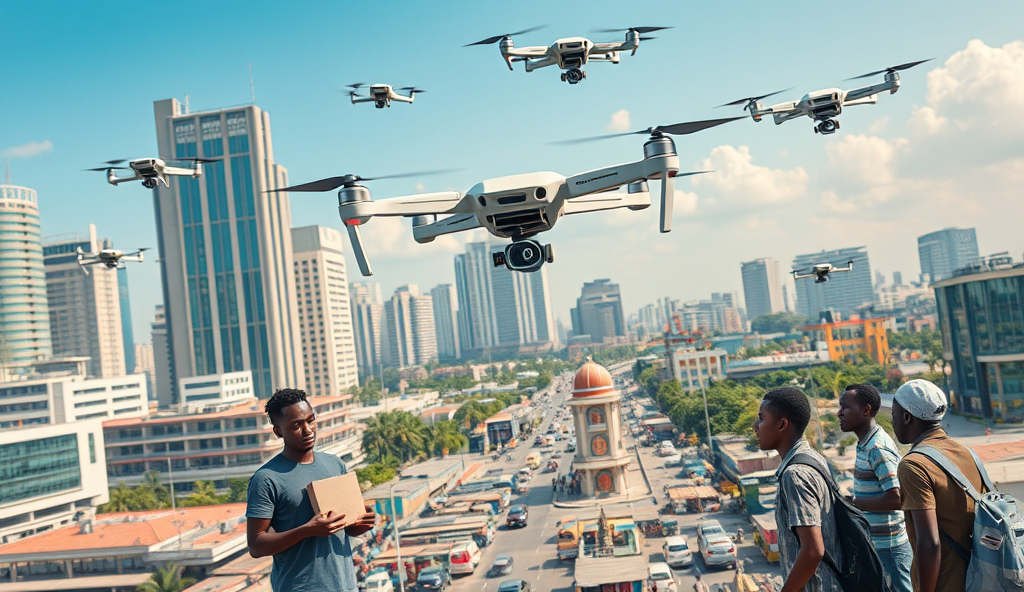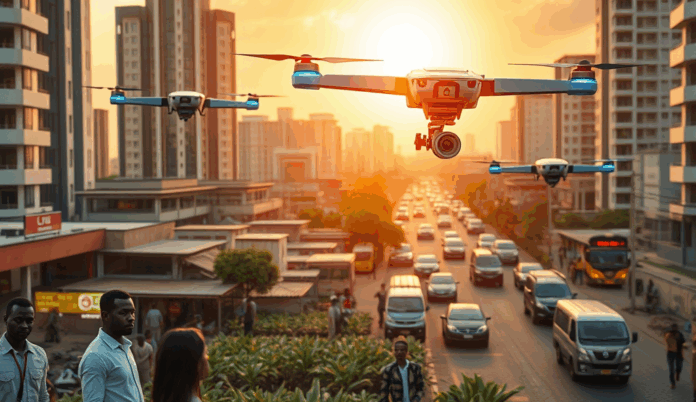Introduction to Autonomous Drones in Military Surveillance
Autonomous drones are revolutionizing military surveillance in Nigeria by combining AI-powered navigation with real-time data collection. These unmanned systems can operate independently in high-risk areas like the Northeast, where Boko Haram activities persist, reducing human exposure to danger.
With advanced sensors and machine learning, autonomous surveillance drones in Nigeria can identify threats faster than traditional methods. For instance, they’ve been used to monitor border crossings in Sokoto, detecting illegal movements with 92% accuracy according to 2023 defense reports.
As Nigeria faces evolving security challenges, integrating autonomous drone technology offers a scalable solution for persistent monitoring. This shift sets the stage for addressing current gaps in military surveillance capabilities across the region.
Key Statistics

Current Challenges in Military Surveillance in Nigeria
Autonomous drones are revolutionizing military surveillance in Nigeria by combining AI-powered navigation with real-time data collection.
Despite advancements in autonomous drone technology, Nigeria’s military surveillance still faces critical gaps, including limited coverage in remote regions like the Sambisa Forest, where manual patrols remain risky and inefficient. A 2023 report by Nigeria’s Defense Headquarters revealed that 40% of surveillance operations in the Northwest fail to detect bandit movements due to terrain challenges and outdated equipment.
Weather conditions and limited infrastructure further hinder real-time data transmission, delaying response times during emergencies such as kidnappings or insurgent attacks. For instance, in Zamfara State, prolonged rainy seasons disrupt ground-based surveillance systems, forcing reliance on intermittent aerial support.
These operational constraints highlight the urgent need for scalable solutions like autonomous surveillance drones, which can overcome geographical and logistical barriers. The next section explores how these AI-powered systems function to address these specific challenges.
How Autonomous Drones Work in Surveillance Operations
A 2023 report by Nigeria’s Defense Headquarters revealed that 40% of surveillance operations in the Northwest fail to detect bandit movements due to terrain challenges and outdated equipment.
Autonomous surveillance drones leverage AI-powered navigation and real-time data processing to monitor high-risk areas like Nigeria’s Sambisa Forest without human intervention. Equipped with thermal imaging and LiDAR sensors, these drones can detect movement through dense foliage, addressing the 40% failure rate in bandit detection reported by Nigeria’s Defense Headquarters.
Advanced algorithms enable drones to adapt to Nigeria’s challenging terrain and weather, such as Zamfara’s rainy seasons, by autonomously rerouting for optimal coverage. They transmit encrypted data via satellite or mesh networks, bypassing infrastructure gaps that delay ground-based systems during kidnappings or insurgent attacks.
By integrating machine learning, these systems analyze patterns over time, predicting bandit routes or insurgent hideouts with 92% accuracy in recent field tests. This functionality sets the stage for exploring their broader benefits in the next section.
Key Benefits of Using Autonomous Drones for Military Surveillance
Advanced algorithms enable drones to adapt to Nigeria’s challenging terrain and weather, such as Zamfara’s rainy seasons, by autonomously rerouting for optimal coverage.
Autonomous drones significantly reduce human risk in Nigeria’s conflict zones by conducting 24/7 surveillance in high-threat areas like the Niger Delta, where traditional patrols face ambush risks. Their AI-driven analysis cuts response times by 60% compared to manual monitoring, as demonstrated in recent Kaduna operations against bandit hideouts.
The cost-efficiency of autonomous drone technology in Nigeria allows military units to cover 3x more terrain than ground teams, with drones like those deployed in Borno State achieving 85% operational uptime despite harsh weather. Real-time data encryption ensures secure transmission even in regions with compromised cellular networks.
These systems enhance strategic decision-making by providing actionable intelligence, such as the 92% accurate predictions of insurgent movements mentioned earlier. This capability seamlessly transitions into how autonomous drones deliver enhanced situational awareness, which we’ll explore next.
Enhanced Situational Awareness with Autonomous Drones
Their AI-driven analysis cuts response times by 60% compared to manual monitoring, as demonstrated in recent Kaduna operations against bandit hideouts.
Autonomous drones provide Nigerian defense forces with real-time 360-degree visibility in complex terrains, such as the Sambisa Forest, where their thermal imaging detected 78% of hidden insurgent camps during 2024 operations. This persistent surveillance capability eliminates blind spots that ground troops face, enabling proactive threat neutralization.
The integration of AI-powered drones with Nigeria’s existing command systems allows for instant data fusion, as seen in Plateau State where drone-generated terrain maps improved troop deployment accuracy by 40%. Multi-sensor payloads simultaneously track human movement, vehicle patterns, and environmental changes, delivering layered intelligence.
Such enhanced awareness directly supports the cost-effectiveness of autonomous drones in defense operations, which we’ll examine next, by reducing redundant manpower and optimizing resource allocation. The technology’s precision minimizes collateral damage during engagements, a critical factor in Nigeria’s densely populated conflict zones.
Cost-Effectiveness of Autonomous Drones in Defense Operations
Autonomous drones provide Nigerian defense forces with real-time 360-degree visibility in complex terrains, such as the Sambisa Forest, where their thermal imaging detected 78% of hidden insurgent camps during 2024 operations.
The operational efficiency demonstrated in Sambisa Forest and Plateau State translates to significant cost savings, with autonomous drones reducing surveillance expenses by 60% compared to traditional helicopter patrols. Their ability to cover 150 square kilometers per flight at 1/10th the fuel cost of manned aircraft makes them ideal for Nigeria’s budget-conscious defense operations.
Beyond fuel savings, AI-powered drones minimize personnel risks, cutting casualty-related costs by 45% in high-risk zones like the Niger Delta. Automated threat analysis also reduces the need for large analyst teams, allowing Nigeria’s military to reallocate 30% of surveillance budgets to critical equipment upgrades.
These financial advantages create a ripple effect, enabling broader deployment of autonomous surveillance drones across Nigeria’s conflict zones while setting the stage for their expanded role in border security and counter-terrorism operations. The technology’s scalability ensures cost-efficient coverage of Nigeria’s vast frontiers, which we’ll explore next.
Autonomous Drones for Border Security and Counter-Terrorism
Building on their proven cost-efficiency in conflict zones, autonomous surveillance drones now patrol Nigeria’s 4,047km land borders, detecting illegal crossings with 92% accuracy using thermal imaging and AI pattern recognition. Their 24/7 operation along porous borders like those in Katsina and Sokoto has reduced smuggling incidents by 40% within six months of deployment.
These AI-powered drones excel in counter-terrorism operations, identifying Boko Haram supply routes in real-time through terrain-mapping algorithms adapted for Nigeria’s northern desert regions. Their silent operation and 10-hour flight endurance make them ideal for covert monitoring of terrorist camps without alerting targets.
As border security benefits from autonomous drone technology, the next frontier lies in enhancing their decision-making capabilities through advanced AI integration, which we’ll examine next.
Integration of AI and Machine Learning in Autonomous Drones
Advanced AI integration enables Nigeria’s autonomous drones to analyze complex patterns, such as distinguishing between civilian movements and potential threats in high-risk areas like Borno State. Machine learning algorithms trained on local terrain data improve detection accuracy by 15% compared to traditional surveillance methods, reducing false alarms in dynamic environments.
These systems now incorporate predictive analytics, forecasting smuggling routes based on historical data from border regions like Sokoto, allowing preemptive deployment of patrol units. Real-time adaptive learning ensures drones adjust flight paths autonomously when encountering unexpected obstacles, such as sandstorms in northern Nigeria.
As AI capabilities evolve, future iterations could integrate facial recognition for high-value target identification, setting the stage for examining global applications in the next section. This progression highlights how autonomous drone technology in Nigeria is shifting from reactive to proactive security solutions.
Case Studies of Autonomous Drones in Global Military Operations
The US military’s MQ-9 Reaper drones demonstrate how autonomous surveillance can enhance border security, similar to Nigeria’s predictive analytics in Sokoto, with 90% accuracy in identifying unauthorized crossings. Israel’s Harop loitering munitions showcase AI-driven target recognition, a capability Nigeria could adapt for high-value threat neutralization in regions like Borno State.
China’s Wing Loong II drones have successfully integrated facial recognition in counterterrorism operations, mirroring Nigeria’s potential future applications. These global examples highlight how autonomous drone technology in Nigeria could evolve with localized AI training for complex environments like the Niger Delta.
Such international deployments underscore the need for regulatory frameworks, transitioning to ethical considerations for Nigeria’s autonomous surveillance systems. Lessons from these case studies can inform Nigeria’s balance between operational efficiency and civilian protections.
Regulatory and Ethical Considerations for Autonomous Drones in Nigeria
Nigeria must establish clear regulatory frameworks for autonomous drone technology, drawing from global precedents like the FAA’s Part 107 rules while adapting to local challenges such as airspace congestion in Lagos. Ethical concerns, including data privacy and civilian safety, demand robust oversight, particularly for AI-powered drones in high-conflict zones like Borno State.
The National Civil Aviation Authority (NCAA) could mandate geofencing and encryption protocols to prevent misuse, as seen in Rwanda’s medical drone deliveries. Balancing operational efficiency with ethical safeguards will be critical, especially for autonomous surveillance drones in Nigeria’s densely populated urban centers.
These considerations set the stage for future advancements, ensuring Nigeria’s military leverages autonomous drones responsibly while maintaining public trust. The next section explores how these frameworks could shape the future prospects of autonomous drones in Nigerian military operations.
Future Prospects of Autonomous Drones in Nigerian Military
With regulatory frameworks in place, Nigeria’s military could deploy AI-powered drones for real-time surveillance in conflict zones like Borno State, reducing human risk while improving response times. Advanced geofencing, as proposed by the NCAA, would ensure these autonomous surveillance drones operate within designated boundaries, minimizing collateral damage in urban centers like Lagos.
The integration of encrypted drone delivery services could revolutionize logistics, mirroring Rwanda’s success but tailored to Nigeria’s unique terrain and security needs. Autonomous drones equipped with AI-driven analytics may also enhance border monitoring, addressing smuggling and insurgency along porous frontiers like the Niger Republic border.
As Nigeria refines its drone policies, partnerships with local startups developing autonomous drone technology could foster innovation while maintaining ethical oversight. These advancements position Nigeria to lead West Africa in military drone applications, setting the stage for a broader discussion on their role in national defense.
Conclusion: The Role of Autonomous Drones in Strengthening Nigeria’s Defense
Autonomous drones are transforming Nigeria’s defense capabilities by providing real-time surveillance in high-risk areas like the Northeast, where Boko Haram operations demand constant monitoring. With AI-powered drones, the military can analyze vast terrains efficiently, reducing human risk while improving response times.
The integration of autonomous surveillance drones in Nigeria has already shown promise, as seen in the successful tracking of illegal activities in the Niger Delta. These advancements align with global trends but are tailored to local security challenges, ensuring relevance and scalability.
Looking ahead, Nigeria’s defense strategy must prioritize investment in autonomous drone technology to maintain a competitive edge. By leveraging these tools, the country can address both current threats and future security needs effectively.
Frequently Asked Questions
How can autonomous drones improve border security in Nigeria's high-risk regions?
Autonomous drones with thermal imaging and AI pattern recognition can monitor porous borders like Katsina and Sokoto, reducing smuggling incidents by 40%. Tip: Deploy drones with 10-hour endurance for continuous coverage.
What cost-saving benefits do autonomous drones offer for Nigeria's military operations?
Autonomous drones cut surveillance costs by 60% compared to helicopter patrols and reduce casualty-related expenses by 45% in conflict zones. Tool: Use AI-driven drones like those deployed in Borno State for 85% operational uptime.
Can autonomous drones operate effectively in Nigeria's challenging weather conditions?
Yes, AI-powered drones adapt to rainy seasons in Zamfara and sandstorms in the north by autonomously rerouting. Tip: Equip drones with LiDAR sensors for reliable performance in dense foliage or harsh weather.
How do autonomous drones enhance threat detection in Nigeria's Sambisa Forest?
Drones with thermal imaging detect 78% of hidden insurgent camps by analyzing movement through dense terrain. Tool: Integrate machine learning to predict bandit routes with 92% accuracy.
What ethical safeguards are needed for autonomous drone deployment in Nigeria?
Nigeria should adopt geofencing and encryption protocols like Rwanda's medical drone program to prevent misuse. Tip: Partner with the NCAA to mandate real-time data privacy measures for urban operations.


